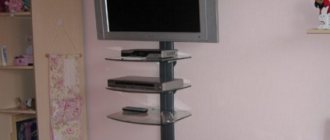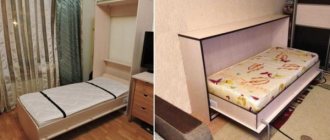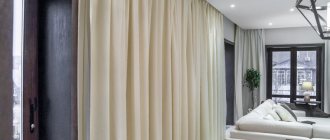The personal hell of a perfectionist is a bunch of wires going down from a TV hanging on the wall. This problem can be dealt with in different ways, including very creative ones. The main question is: at what stage will you do this? We will tell you about all the options: from complex ones to those that can be dealt with within an hour.
Ways to hide wires:
- Inside the wall
- Using a decorative panel
- In a box
- Make them part of the decor
- Use furniture
Content:
- 1 Selecting the optimal wire arrangement
- 2 3 ways to hide wires on the wall without cutting or repairing 2.1 Decorating the wire
- 2.2 Use of external cable channels or special boxes
- 2.3 Special cable clamps
Televisions work from the network, like most household appliances. In addition to the cable with a plug for a 220V socket, there is often another wire connected to the TV, through which terrestrial, cable or satellite television is broadcast. And if a set-top box, game console or DVD player is connected to the device, the number of cables increases significantly. All this affects the design of the room, even worsening the aesthetic perception of watching films. The situation can be corrected. All you have to do is decide how to hide the wires from the TV: in a box, along the wall, or run them along the floor.
Hide the extension cord with chargers in a box
The extension cord with chargers constantly gets in the way on the table or under your feet, collects a lot of dust, and also looks unaesthetic. Dealing with this problem is very simple: take a nice box, make a few holes in it and hide all the wires and cables there.
1 / 0
homedit.com
2 / 0
homedit.com
3 / 0
homedit.com
There are also ready-made solutions, for example Plug Hub from Quirky. This is a box made of hard plastic with a rubberized bottom. There are three holes on top for cables, and inside there are three fasteners that can be used to wrap cords that are too long. The Plug Hub can be placed on the floor or mounted on the wall.
amazon.com
Choosing the optimal wire arrangement
To decide how to hide the wires, you need to consider their length and structure. When laying along a wall or along a ceiling, cables must not be stretched. If you do not leave a reserve near the TV or outlet itself, there will be a large load on the plug, and eventually it or the connector will fail.
It is also not allowed to work with uninsulated wires. It happens that the cable loses its integrity during operation. Areas with cracks or chips in the top insulating layer must be additionally wrapped with electrical tape or replaced with a new wire.
It is also worth considering:
- How many wires are planned to be hidden? For one or two, it’s easy to drill holes of the required length or purchase cable channels. It is better to tuck a large number of cables into the wall behind plasterboards.
- Desired Location: Ceiling wiring will require longer cable lengths than floor wiring.
- Distance to socket. If the TV is located next to the power source, you can simply disguise or decorate the cable so that it is not noticeable.
- Safety indicator. In apartments or houses with small children and pets, special attention should be paid to hiding wires. They should be located in an inaccessible place, for example, in a box or in a wall. But don’t just lie on top of the baseboard.
Let's look in more detail at all the options on how to beautifully, neatly and safely hide the wires from the TV.
How to remove cables into the wall itself
Covering the wires from the TV in the wall itself is the optimal, safe, but most labor-intensive process. It cannot be done without repairs. Therefore, internal electrical wiring is planned at the stage of major restoration or entry into a new apartment.
The steps on how to remove wires from the wall are as follows:
- Order an electrical wiring project for your apartment or room. Only an electrician can calculate the number of sockets required, the width of the technological holes and the correct routing of all wires.
- Draw straight lines on the wall with a pencil or marker. These are the outlines along which the technological holes will be made.
- Prepare equipment and cut holes according to the given plan. Clear them. Route the main cables and connect the sockets.
- Place electrical wiring in cable channels to increase the safety of its operation. You can also place a wire there to connect terrestrial or cable television.
- Close the holes, leaving access hatches to check the integrity and repair the wiring.
- Make repairs.
Important. All this must be done before the apartment is completely renovated. It is better to connect the outlet directly to the TV, then you will not need additional methods to hide the wires.
If the renovation has already been done, but you want to remove the cables from household appliances into the wall, you can carefully cut small lines to the baseboard. And let the rest of the route follow it. For this purpose, special skirting boards are produced with an internal cavity that allows you to hide the wiring from prying eyes.
Briefly about the main thing
If you want to update your interior, but repairs are out of the question, simple and low-cost methods come to the rescue. Little life hacks will help you refresh your design and transform your room to suit your mood. Their choice is varied, and you can always choose the appropriate option in accordance with the style of the room and your taste.
Among the popular methods, the palm belongs to crafts made from natural materials, especially wood. Often the simplest and most profitable way is to use old things and improvised means. Those who have any skill are especially advantageous: they know how to knit, sew, woodwork, or have mastered the technique of appliqué or macrame. Most decorative methods have limitations in application, as they are not suitable for all interior styles.
Is it possible to hide wiring in the floor?
The easiest way to hide the wires from the TV in the floor is to buy special plinths with a cavity inside. This is a fast, clean and inexpensive way to route cables around your home. Moreover, it will be just as easy to free access to the desired section of the cord and check its integrity - just dismantle the plinth and then put everything back.
The antenna wire from the TV can be easily hidden in the floor itself. To do this you will need:
- Make small technological holes in the concrete floor using a hammer drill.
- Insert a wire into it. Cover with decorative material or level the floor with a screed.
Important. If the apartment has wooden floors, they will have to be dismantled. There is no need to destroy the integrity of parquet or laminate. The wiring will only require a small hole at the entrance and exit of the wire.
Decor with stickers, stickers, improvised means
Decorative elements that help hide or neatly secure numerous cords are sold almost everywhere and are quite inexpensive. In this way you can decorate the cord coming from the sconce above the bed in the bedroom. You can decorate the cable from the TV or the cord from the heater running along the floor using a “toy” mini-fence glued to the baseboard. If you plan to carefully hide many elements behind a fence, tie clamps are used.
Decorative clamps are now sold in all electrical stores. They are an adjustable flexible clip decorated with leaves, flowers, butterflies, birds, and houses. In romantic interiors, laces are decorated with sparkles and feathers, in a children's room - with stickers depicting fairy tale characters and favorite cartoons.
Running cables along the ceiling
Placing wires from TV and other household appliances under the ceiling is one of the safest ways to hide them from children and animals. Moreover, to create such a system it is not necessary to cut and make technological excavations. You can choose one of the following methods:
- External wiring using fireproof protective sleeves (corrugations). They are matched to the color of the ceiling trim. And they are simply fixed with brackets to the ceiling.
- The use of ceiling plinths with technological holes for electrical wiring. The fastest and most affordable way. It is enough to fix the baseboards and run the wires along them to the exit point. From it, boxes are lowered along the wall or wires are removed into the wall.
- Hiding wiring under suspended ceilings. The design includes a special frame to which wires or wiring boxes can be attached.
Important. When running even wires from a TV, it is important to follow safety precautions. Each cable must be insulated. When wiring several wires at once, they are placed in fireproof corrugations.
How to hide TV wires behind furniture
The owner of an apartment or house wants there to be as few wires as possible, or rather, so that they are not visible. To quickly hide cables, you can buy special furniture that already has technological holes for the antenna or cable wire.
Most often, such furniture includes TV stands. They are equipped with a hole where all wires can be easily and quickly removed. And discreetly connect them to the nearest outlet. The same cabinets can have pull-out shelves for TV set-top boxes, DVD players and other equipment.
Advice. Place the TV stand as close to the outlet as possible. If this is not possible, you can run an extension cord under the baseboard and bring the power source as close and unnoticed as possible.
Use books and magazines
Even books can be good helpers in trying to hide television wires. Try to choose ones that have a neat, aesthetic appearance or with bright covers.
Books and magazines can be stacked on a table or shelf under the TV. Pick up a couple of high-end editions that will reach all the way to the television panel. Don't overdo it with the quantity - keep it small so as not to create a mess.
Original and simple methods on how to hide wires from a TV
Designers and simple room owners with a rich imagination come up with unusual ways to hide the wires from the TV and at the same time decorate an apartment or house. The simplest and most original options include:
- Place them on the nightstand and cover them with books or special decorative elements. The main thing is not to forget that books are worth looking at, not for reading.
- Braid the wires with thick rope, turning them into a real apartment decoration, from which you can create a tree on the wall or any other design.
- Placing a phytowall is a modern solution for stylish apartments. This is a special panel with pockets for indoor plants. It is enough to place the TV with its back to a living wall and run the cable behind it to neatly and beautifully hide all the wires. At the same time, this design of the TV zone will help you completely relax while watching TV.
- Installation of decorative furniture. If the TV is fixed to the wall, the wires run down and ruin the design. To hide them, just create a thin cabinet under the TV. It will look stylish and at the same time cover the wiring and socket for the TV.
There are a lot of options for hiding wires from household appliances on the wall, ceiling and floor. Choose any one that suits the design of the room, and don’t be afraid to create. But do not forget about safety precautions.
Various methods of disguise
There are a large number of methods for laying and masking wires, which differ from each other in labor intensity, aesthetics, safety and other features. The only thing they have in common is that they do not require gouging out recesses in the walls (gouging).
Corrugated sleeve
This rigid pipe not only protects wires from various types of damage, but has a number of other advantages.
Advantages of corrugated pipes:
- flexibility - the product can be easily installed in rooms of different configurations;
- protect wires from electromagnetic influence of various emitters;
- protect the room from the induced electromagnetic field that occurs when alternating current passes through the wires.
The big disadvantage of corrugated sleeves is the low aesthetics of this product. It is more suitable for technical rooms and looks extremely unnatural in living rooms. In the latter case, you have to resort to additional decoration - if the sleeve is stretched in a visible place.
The corrugated pipe does not hold its shape well, so it will be located parallel to the floor surface if it is fixed to the ceiling or floor. Typically, corrugated hoses are used when it is necessary to collect all the cables in one bundle. This format is rarely used in residential premises.
Flat cable
A flat cable, which is quite simply attached to the wall, and then sealed with a thin layer of plaster, allows you to do without gating.
In order to avoid mistakes when carrying out work, it is recommended to sketch out a small diagram in advance - exactly how the wires will pass, where the sockets and switches will be located.
The flat cable is secured to the wall using:
- metal ties;
- plastic dowel clamps;
- quick-drying plaster;
- plastic mounting pads.
A drill is usually used to prepare a place for fittings. When the cable is fixed, plaster is applied to the wall - 10 mm thick.
Cable channel
These are plastic boxes, mostly rectangular in cross-section, into which electrical cords are placed. One of the simplest, most convenient, reliable and safe ways to lay cables after finishing.
Cable channels are especially often installed in the kitchen after repairs have been made, and later this or that equipment has been purchased, for example, a washing machine, air conditioning, lighting fixtures.
Features of these channels:
- you can find products of a suitable color - manufacturers produce different options;
- easily replaced and supplemented with new branches;
- made of non-flammable materials;
- reliably protect electrical wiring or other wires from mechanical damage and sunlight.
It is quite difficult to choose cable channels of a suitable color for interiors decorated in ECO, Empire, and Baroque styles. But in any case, laying it in a channel is better than wires hanging on the walls.
To make channel boxes, not only plastic can be used, but also metal - galvanized steel or anodized aluminum.
Possible box section:
- U-shaped;
- W-shaped;
- triangular;
- semicircular.
Boxes to walls or floors are made using self-tapping screws, dowels, iron brackets or anchors. Along with solid options, there are also flexible analogues made of rubber or wire, as well as transparent channels.
Disguise in furniture
Furniture offers great opportunities for masking wires. Behind its vast surfaces you can hide as many wires as you like.
How to hide cables behind furniture:
- fix on the back wall of the cabinet;
- hide behind the table leg;
- secure under the tabletop;
- hide behind a mirror, curtain, vase, large and dense plant.
For fixation, use special holders. You can use reusable plastic clips with Velcro tape. If you are afraid of damaging the surface of the furniture, use regular masking tape. The wires can be disguised by securing them to the back of the tabletop or cabinet.
Use one of the following methods:
- Self-tapping screws. Take fasteners whose length does not exceed the thickness of the tabletop. Typically 3.5x16 mm self-tapping screws are used.
- With double-sided tape. This is not the most reliable option, but it makes it easy to model and adjust the laying pattern.
If you don't want to make holes in your furniture, it is recommended to use perforated screens.
Camouflage covers
You can make a cover for masking wires yourself. It manages to hide several cables at once. The cover is made from plastic bags cut into long strips. They are crocheted into a sleeve into which the wires are threaded. For an extension cord with charges, knit/sew a bag of a suitable size.
In some stores you can also buy plastic covers in the shape of trees, pipes, sparkling snakes. In such designs, unlike cable channels, there are no protective properties; they simply cover the wires, spoiling the aesthetics of the interior.
To make the wires more decorative, you can also purchase spiral braiding - flexible and aesthetic. It can hide either one wire or a whole bunch of them.
Beads and multi-colored electrical tape
With the help of beads and electrical tape, the wire can be transformed into a stylish interior detail. And you don’t even need to pick it up from the floor. It is enough to decorate it with beautiful decor.
Suitable wire decor:
- large beads;
- colored electrical tape;
- textured twine;
- bright threads, etc.
If the wire is thin enough, you can put large beads on it. This technique is often used by designers when creating ethnic motifs. The main thing is to choose the right color of the beads. It should be harmoniously combined with the overall color scheme of the interior.
Decorating with beads will not only give the wire a presentable look, but will also prevent it from wearing out. Thanks to the beads, friction between the wire and the floor will be reduced, so it will last longer.
Installations on the wall
You don’t have to hide the wires anywhere, but on the contrary, put them on display, turning them into an independent art object. To create a “panel” you will need an empty wall. One should be plain, otherwise it will not be possible to achieve the desired decorative effect.
Show your creativity and imagination - create an unusual pattern from wires. To create a stylish installation, you need to carefully consider the contours of the design, otherwise the wire on the wall will look tasteless and shabby.
Recommended installation options:
- abstract images;
- geometric figures;
- silhouettes of houses, etc.
Such installations are inorganic in classic interiors; this solution is suitable for modern design - high-tech, loft, etc. styles.
The wire is bent at a certain angle and fixed to the wall. They should be reliable, but inconspicuous. Before “drawing” a picture from wires, it is first drawn on paper - this simplifies the installation process.
Vinyl stickers
Installations on the walls will look even more interesting if you decorate them with vinyl stickers. They can decorate even a very small piece of wire. The stickers are easy and simple to apply. To ensure they adhere well, they should be applied to smooth, clean surfaces. There are no traces left after the stickers.
You can “draw” a tree using a wire, and vinyl stickers will be its leaves, flowers, and the plinth will pass for soil. Or you can make a separate branch from the wire and place vinyl birds on it. LED garlands, multi-colored ribbons, feathers, etc. will help enhance the effect.
Decorative holders
It happens that there is no free wall in the room to create an installation of wires, then they can be decorated with decorative holders. Structurally, they are ordinary clamps and securely hold the cable.
They differ from ordinary clips only in appearance - they have an interesting design and may contain various decorative elements - leaves, bird figures, etc. Fixation condition - the hole of the clips must fit the size of the cable.
The holders can be replaced with decorative overlays or ties - they will present in a favorable light the most discreet cable stretched along the wall. Thus, a cover imitating a metal pipe will look harmonious in a living room designed in a loft style.
Organizer
If there are a lot of wires concentrated at one point, they can be placed in a plastic box - an organizer. This will eliminate clutter, reduce cleaning time, and increase safety.
There is no need to look for any “suitable boxes”; organizers for wires and all electrical equipment can be bought in the store. These are stylish plastic boxes with ventilation holes and silicone legs.
A variety of elements are placed inside the organizer:
- wires;
- network filter;
- Charger;
- router
But if you wish, you can make such an organizer yourself. An old shoe box or wooden bread box is suitable for this purpose. All you have to do is make holes in them and decorate them to your liking.
A kind of organizer can be made from a cardboard shoe box. To do this, just cut out the side holes in it to let the wires through. This product is suitable for an extension cord to which many wires are connected.
Another solution is to buy a cabinet that has a built-in niche for cables. Or you can dedicate a whole box for wires. You can place an extension cord and gadget chargers there. This will remove the tangle of wires and bring order to the workplace.
Art object
Draw a picture on the wall with a simple pencil. And lay the cable along the drawn outlines. This will allow you to get a picture of wires that matches the design of the apartment.
Disguise behind flowers
The cable is secured to the wall with some kind of clamps. Preferably discreet and transparent. And along the wiring lines, hanging flower stands are installed. Hanging and climbing plants are planted in them. If you don’t want to deal with flowers, you can replace them with artificial analogues.
Masking wires from lamps
Currently, indoor spot lighting is becoming popular. At the same time, long wires stretch from hanging lamps, which spoil the aesthetics of the room.
The cords are hidden behind special panels, which can be purchased at any construction site. Manufacturers offer products in a variety of shapes and colors - you can choose them to match the interior of the room.
What you need to know when working with TV cables
Cable and terrestrial television is carried into the apartment via wires. There are also wires coming from the TV itself. And when decorating them, do not forget that you are working with electricity, which requires compliance with safety regulations. Namely:
- Electrical wiring around the apartment can only be done in a de-energized room and with permission to carry out such work. For this purpose, electricians are invited at the stage of major repairs.
- Wires can be removed into cable ducts or into baseboards only when household appliances are turned off.
- Decorating cables with any elements is permitted if the following conditions are met: the equipment is disconnected from the network and the integrity of the insulating braid of the wire is not compromised.
Do not forget that you cannot connect all additional equipment tightly. The plugs must be freely connected to the connectors to ensure high-quality and long-term operation of the devices.
Found a mistake? Select it and press ctrl+enter
- 80
Useful tips
In order not to get confused when masking the wires and not to get into trouble during repairs, they must be marked in advance. This will help you immediately find the right cable later. It is better to separate low-power wiring from power wiring, without connecting it into a single bundle. Wires from the antenna and the Internet should be placed separately from others so as not to spoil the signal quality.
Cables should have the shortest possible length and the minimum number of connections: this increases their safety and reduces the risk of injury. It happens that the braid of hidden cables frays due to poor placement, so in dangerous places the wiring must be checked more often. If you need to mask wiring, you can use any ideas, especially since the range of tools and materials for decoration is now huge!











